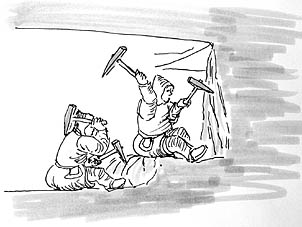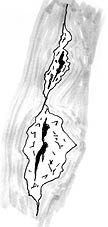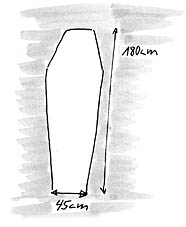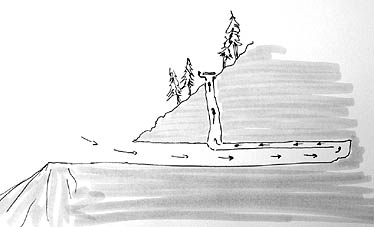Mining activities exist since the year 1000 in St. Marie aux Mines and its valley. During the run for silver in the 16th century, with the arrival of about 3000 miners, the village with its 400 habitants became the third most important city of the entire region, besides Strasbourg and Colmar.
At first vertical pits were dug, which had one mayor drawback, seeping water. This old technique required a lot of additional work as the water had to be removed by hand with buckets. In the new mining technique, horizontal galleries were dug by two men, in a sitting position. The fist had the responsibility of following the vein; the second was responsible for a slightly ascending gallery. This allowed evacuating the entering water easily.


The mineral vein consists of the ore, the usable substance and the potch, which is the sterile substance. The ore composed of, silver, copper, arsenic, cobalt, lead and metals of no economical interest, as their use or extraction was not know at the time: zinc, iron, manganese, nickel, antimony, bismuth and others in form of traces. The substances like quartz, barytine, fluorite, calcite dolomite, iron carbonate etc. composed the potch.
It is the metamorphic gneiss, which contains all the veins in St. Marie aux Mines. It is not usefull to search the neighboring granites.

The profile of the galleries is an indicator of the success and richness of the vein. If the profile is narrow and even, this indicates that the miners just followed the vein that varied in size between one to a few centimeters. When they encountered a rich part, the profile opened to follow de shape of the vein.
The miners advanced from 10 to 20 cm per day. During the poor months or years, only two miners were advancing the gallery, following the vein and hoping to find a rich portion. In this case the mining corporation hired more miners depending the available space in the shaft. With the force of their hands these miners excavated more than 300 km of galleries.
A system of rails with wagons of about 20 cm in width and between 50 and 60 cm of height was used to evacuate the ore and the sterile potch.
As air circulation in the mine is essential, a simple but efficient system was invented. A double ceiling in wood was installed in the gallery and sealed with clay. An airshaft was built close to the entrance but at a different level. This produced an air circulation like a chimney. The double ceiling served as a ventilation case, bringing fresh air to the end of the gallery.
In winter, the cold air enters the gallery and warms up due to the ambivalent temperature within the mine, which is constant at about 8° Celsius all year round. The warmed air becomes lighter and moved out of the gallery trough the double ceiling. During summer only the direction of the circulation is reversed.

The "Seigneur de Ribeaupierre" and the "Duc de Lorraine" sold concessions to the investors to exploit the mines. In addition to the concession the mining societies paid a 10% tax on the production. The miners were paid weekly for 8-hour day shifts. The minimum age to work in the mines was between 14 and 15 years. The miners paid a share to an insurance, the "Knappschaftskasse" who attributed reimbursable loans in case of an accident or illness of a miner. But it also paid the salary of the priest and the education of the children !
The mining activity went through numerous cycles of poor and successful years. The discovery of silver mines in Brazil, who produced at lower cost, affected deeply the mining industry in St. Marie aux Mines. A last successful activity in the 18th century was due to the invention of black powder, dynamite. The last silver mine ceased its activity in 1904 and the last arsenic mine in 1940.
Of the 100 abandoned galleries, about ten are reopened, restored and securised to receive visitors and offer a voyage through time.
After a visit to one of these mines the exposition Euro-Mineral at St. Marie aux Mines, takes all of a sudden another quality, and one can imagine easier the hard working condition of these miners. But the past is not that far, these ancient mining techniques have not disappeared. The mines in Burma, in Madagascar and in other developing countries still function with these ancient techniques. One regrets only that the social structures around these new exploitations do not live up to the ones developed during the 16th century in St. Marie aux Mines.
Hubert Heldner August 2004
|